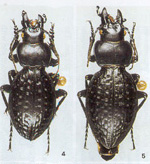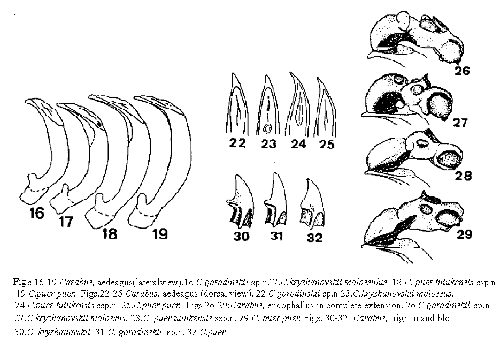Résumé: Une nouvelle espèce: C. (Cratocarabus) gorodinskii sp. n. et six nouvelles sous- espèces: C. (Pantophyrtus) turcomanorum sepositus ssp. n., C. (Pantophyrtus) turcomanorum orbitosus ssp. n., C. (Cratocechenus) akinini oitalensis ssp. ?, C. (Cratocechenus) akinini intestinus ssp. n., C. (Cratocarabus) puer tuiukensis ssp. n. and C. (Scambocarabus) modestulus tschernyschovi ssp. n. sont décrites de Chine, Kirghizie et Kazakhstan. Leurs caractères distinctifs sont analysés.
Abstract: One new species: C. (Cratocarabus) gorodinskii sp. n. and six new subspecies: C. (Pantophyrtus) turcomanorum sepositus ssp. n., C. (Pantophyrtus) turcomanorum orbitosus ssp. n., C. (Cratocechenus) akinini oitalensis ssp. n., C. (Cratocechenus) akinini intestinus ssp. n., C. (Cratocarabus) puer tuiukensis ssp. n. and C. (Scambocarabus) modestulus tschernyschovi ssp. n. are described from China, Kirghizia and Kazakhstan. The distinguishing characters are discussed.
Key words: Coleoptera, Carabidae, Carabus, new taxa, China, Kirghizia, Kazakhstan.
Acknowledgments. 1 wish to express my heartly gratitude to Dr. M. DANILEVSKY (Moscow), Mr. S.TOROPOV (Bishkek), Mr. L.CHERNYSHEV (Zhukovsky), Mr. A. GORODINSKI (Moscow), Mr. A. SHAMAEV (Moscow), Mr. E. TARASOV (Moscow), Mr. A. EVSTIGNEEV (Moscow) and Mr P.GORBACHEV (Sochi) who provided me with the materials for study.
Carabus (Cratocarabus) gorodinskii sp. n.
(Figs 4, 5, 16, 22, 26, 31).
Holotype (Fig. 4): male, China, Boro-Khoro Mt. Range, about 100 km from Yining (Kuldzha) to the East, Nilka environs, 1500 m, 13.V.1997(in the collection of ?. Shamaev, Moscow). Paratypes: 1 (male, 1 female (Fig. 5), same date and same locality, (in the collections of A. Shamaev and A. Gorodinski, Moscow).
Description. Body length in males 16.8 - 17.2 mm (including mandibles), width 5.6- 6.0 mm; body length in female 18.0 mm, width 7.8 mm.
Colour black; margins of elytrae with weak blue lustre.
Head moderately males or strongly female thickened, ratio width of pronotum/width of head 1.70 males, 1.56 female; eyes convex; mandibles moderately elongate, slightly incurved, their interior edges nearly straight, apex of mandibles obtuse; terebral tooth of the right mandible (Fig. 31) interflows with retinaculum, less prominent than in C. kryzhanovskii; surface of mandibles smooth. Frontal furrows interfluent, shallow, inside smooth; frons smooth; labrum not wider than clypeus, strongly notched, with two lateral setae. Antennae short, protruding beyond the base of pronotum by two males or one female apical joints; palpi moderately dilated; the last but one joint of the maxillary palpi equal to the last joint; the last but one joint of the labial palpi with 3-5 setae. Mentum tooth triangular; slightly shorter than lateral lobes; submentum with two setae.
Pronotum transverse, broadest before middle; ratio width/length 1.65 males, 1.57 female. Sides of pronotum evenly rounded; lobes of hind angles very short, slightly bent downwards; sides of pronotum narrowly margined. Pronotal disk smooth, posteriorly with few coarse punctures; median longitudinal line deep; basal foveae shallow, inside with sparse and coarse punctures. Lateral margin with two setiferous pores: one pore before the middle and one pore near hind angle.
Elytrae oval, strongly convex, widest at about middle; shoulders evenly rounded; sides of elytrae narrowly margined. Ratio length/width 1.56 males, 1.52 female; ratio width of elytrae/width of pronotum 1.37 males, 1.30 female. Elytral sculpture strongly smoothed; all elytral interspaces interflowing transverse, interrupted by very big and coarse foveoles; striae finely punctured, partially reduced.
Metepisterna smooth, slightly longer than its width; abdominal sternites smooth, lateraly coarsely wrinkled; sternal sulci well-marked. Legs relatively short; 4 segments of fore tarsi in males dilated with dense pubescence on ventral side.
Aedeagus (Figs 16, 22) incurved near basis, distal part nearly straight; apical lamella evenly rounded, slightly bent downwards; endophallus (Fig. 26): prepraeputial lobes strongly convex, ostium lobe reduced.
Head moderately males or strongly female thickened, ratio width of pronotum/width of head 1.70 males, 1.56 female; eyes convex; mandibles moderately elongate, slightly incurved, their interior edges nearly straight, apex of mandibles obtuse; terebral tooth of the right mandible (Fig. 31) interflows with retinaculum, less prominent than in C. kryzhanovskii; surface of mandibles smooth. Frontal furrows interfluent, shallow, inside smooth; frons smooth; labrum not wider than clypeus, strongly notched, with two lateral setae. Antennae short, protruding beyond the base of pronotum by two males or one female apical joints; palpi moderately dilated; the last but one joint of the maxillary palpi equal to the last joint; the last but one joint of the labial palpi with 3-5 setae. Mentum tooth triangular; slightly shorter than lateral lobes; submentum with two setae.
Pronotum transverse, broadest before middle; ratio width/length 1.65 males, 1.57 female. Sides of pronotum evenly rounded; lobes of hind angles very short, slightly bent downwards; sides of pronotum narrowly margined. Pronotal disk smooth, posteriorly with few coarse punctures; median longitudinal line deep; basal foveae shallow, inside with sparse and coarse punctures. Lateral margin with two setiferous pores: one pore before the middle and one pore near hind angle.
Elytrae oval, strongly convex, widest at about middle; shoulders evenly rounded; sides of elytrae narrowly margined. Ratio length/width 1.56 males, 1.52 female; ratio width of elytrae/width of pronotum 1.37 males, 1.30 female. Elytral sculpture strongly smoothed; all elytral interspaces interflowing transverse, interrupted by very big and coarse foveoles; striae finely punctured, partially reduced.
Metepisterna smooth, slightly longer than its width; abdominal sternites smooth, lateraly coarsely wrinkled; sternal sulci well-marked. Legs relatively short; 4 segments of fore tarsi in males dilated with dense pubescence on ventral side.
Aedeagus (Figs 16, 22) incurved near basis, distal part nearly straight; apical lamella evenly rounded, slightly bent downwards; endophallus (Fig. 26): prepraeputial lobes strongly convex, ostium lobe reduced.
Discussion. The new species slightly resembles C. kryzhanovskii molossulus Deuve, 1993, but differs from the latter by shape of aedeagus (Figs 16, 17, 22, 23) and endophallus structure (Figs 26, 27). Elytral foveoles of the new taxa much coarser and biger; pronotum narrower, pronotal disk smoother; head less thickened; mandibles longer and narrower; mentum tooth longer.
Terebral tooth of the right mandible less prominent than in C. kryzhanovskii, but not so smoothed as in C.puer (Figs 30, 31, 32). The new species strongly differs from C.puer by shape of aedeagus (Figs 16, 18, 19, 22, 24, 25) and endophallus structure (Figs 26, 28, 29).
Terebral tooth of the right mandible less prominent than in C. kryzhanovskii, but not so smoothed as in C.puer (Figs 30, 31, 32). The new species strongly differs from C.puer by shape of aedeagus (Figs 16, 18, 19, 22, 24, 25) and endophallus structure (Figs 26, 28, 29).
Distribution and biotope. Only one population near Nilka vil. (Boro-Khoro Mt Range) is known. The beetles were collected at the slopes with Urtica sp. brakes, from under the stones, at the altitudes about 1500 ? above sea level.
Etymology. The species is named in honour of Mr. Andre Gorodinski (Moscow), who collected the first specimen
Remark:H. Schultze & F. Kleinfeld (1995) considered C. kryzhanovskii Bogatchev, 1965 as a synonym of C.puer Morawitz, 1886. These two taxa are very different morphologically and strongly differ by shape of terebral tooth of the right mandible, shape of aedeagus and endophallus structure. Besides C. kryzhanovskii s. str. (Type locality: West China, Sinzian, Kuruk Tag Mt Range, Shirtala) is distributed very far from the area of C.puer s. str. (Type locality: Central Tian-Shan; Ottuk near Son- Kel lake)


